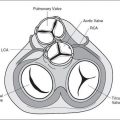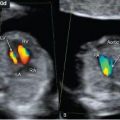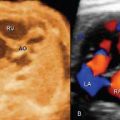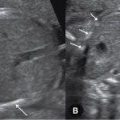IN FETAL
ECHOCARDIOGRAPHY
7
 INTRODUCTION
INTRODUCTION
Color and pulsed Doppler ultrasound was introduced to clinical practice about two decades ago and its clinical application in fetal echocardiography was quickly accepted (1–7). Color and pulsed Doppler ultrasound is currently available on almost all mid- and high-end ultrasound equipment involved in obstetric sonography. When imaging the fetal heart on ultrasound, some examiners recommend limiting the use of color Doppler to high-risk conditions such as the presence of a suspected anatomic or functional cardiac abnormality. Other examiners recommend the routine use of color Doppler as an integral component of fetal cardiac evaluation in every fetus, arguing that its routine use increases both the accuracy and speed of the examination (8–10). There is general agreement, however, that when the fetal heart is examined in detail as part of a fetal echocardiogram, the routine application of color Doppler is warranted. In a recent consensus statement, the International Society of Ultrasound in Obstetrics and Gynecology stated that color Doppler ultrasonography is an important component of the fetal echocardiogram and recommended its mandatory use in that setting and that the additional use of power Doppler is optional (11). We recommend the liberal use of color Doppler in the ultrasound examination of the fetal heart and that color Doppler should be part of fetal echocardiography.
In this book, the use of color Doppler as it pertains to the diagnosis of cardiac malformations is described in the respective chapters on cardiac anomalies. Table 7-1 summarizes the clinical information that can be provided by color Doppler in normal and abnormal hearts. This chapter will focus on the optimization of color Doppler in fetal imaging and on the targeted anatomic cardiac planes evaluated by color Doppler ultrasonography.
 OPTIMIZING COLOR DOPPLER FOR THE FETAL CARDIAC EXAMINATION
OPTIMIZING COLOR DOPPLER FOR THE FETAL CARDIAC EXAMINATION
Stay updated, free articles. Join our Telegram channel

Full access? Get Clinical Tree







